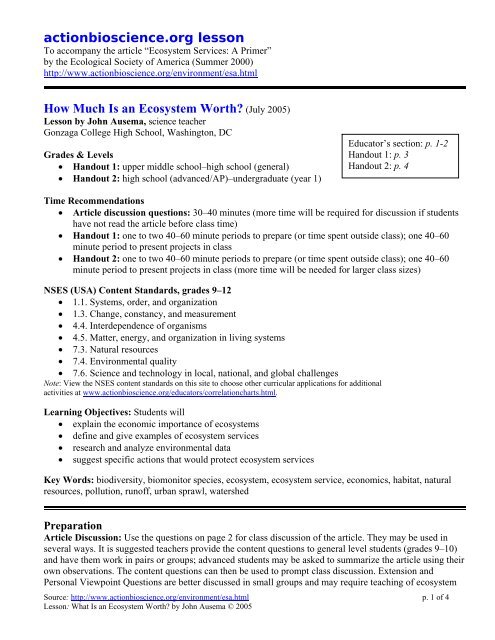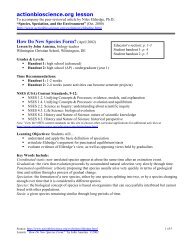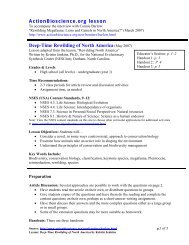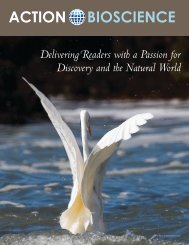How Much Is an Ecosystem Worth? - Action Bioscience
How Much Is an Ecosystem Worth? - Action Bioscience
How Much Is an Ecosystem Worth? - Action Bioscience
You also want an ePaper? Increase the reach of your titles
YUMPU automatically turns print PDFs into web optimized ePapers that Google loves.
actionbioscience.org lessonTo accomp<strong>an</strong>y the article “<strong>Ecosystem</strong> Services: A Primer”by the Ecological Society of America (Summer 2000)http://www.actionbioscience.org/environment/esa.html<strong>How</strong> <strong>Much</strong> <strong>Is</strong> <strong>an</strong> <strong>Ecosystem</strong> <strong>Worth</strong>? (July 2005)Lesson by John Ausema, science teacherGonzaga College High School, Washington, DCGrades & Levels• H<strong>an</strong>dout 1: upper middle school–high school (general)• H<strong>an</strong>dout 2: high school (adv<strong>an</strong>ced/AP)–undergraduate (year 1)Educator’s section: p. 1-2H<strong>an</strong>dout 1: p. 3H<strong>an</strong>dout 2: p. 4Time Recommendations• Article discussion questions: 30–40 minutes (more time will be required for discussion if studentshave not read the article before class time)• H<strong>an</strong>dout 1: one to two 40–60 minute periods to prepare (or time spent outside class); one 40–60minute period to present projects in class• H<strong>an</strong>dout 2: one to two 40–60 minute periods to prepare (or time spent outside class); one 40–60minute period to present projects in class (more time will be needed for larger class sizes)NSES (USA) Content St<strong>an</strong>dards, grades 9–12• 1.1. Systems, order, <strong>an</strong>d org<strong>an</strong>ization• 1.3. Ch<strong>an</strong>ge, const<strong>an</strong>cy, <strong>an</strong>d measurement• 4.4. Interdependence of org<strong>an</strong>isms• 4.5. Matter, energy, <strong>an</strong>d org<strong>an</strong>ization in living systems• 7.3. Natural resources• 7.4. Environmental quality• 7.6. Science <strong>an</strong>d technology in local, national, <strong>an</strong>d global challengesNote: View the NSES content st<strong>an</strong>dards on this site to choose other curricular applications for additionalactivities at www.actionbioscience.org/educators/correlationcharts.html.Learning Objectives: Students will• explain the economic import<strong>an</strong>ce of ecosystems• define <strong>an</strong>d give examples of ecosystem services• research <strong>an</strong>d <strong>an</strong>alyze environmental data• suggest specific actions that would protect ecosystem servicesKey Words: biodiversity, biomonitor species, ecosystem, ecosystem service, economics, habitat, naturalresources, pollution, runoff, urb<strong>an</strong> sprawl, watershedPreparationArticle Discussion: Use the questions on page 2 for class discussion of the article. They may be used inseveral ways. It is suggested teachers provide the content questions to general level students (grades 9–10)<strong>an</strong>d have them work in pairs or groups; adv<strong>an</strong>ced students may be asked to summarize the article using theirown observations. The content questions c<strong>an</strong> then be used to prompt class discussion. Extension <strong>an</strong>dPersonal Viewpoint Questions are better discussed in small groups <strong>an</strong>d may require teaching of ecosystemSource: http://www.actionbioscience.org/environment/esa.html p. 1 of 4Lesson: What <strong>Is</strong> <strong>an</strong> <strong>Ecosystem</strong> <strong>Worth</strong>? by John Ausema © 2005
<strong>How</strong> <strong>Much</strong> <strong>Is</strong> <strong>an</strong> <strong>Ecosystem</strong> <strong>Worth</strong>?concepts beyond what is found in the article. Refer to the Active Learning Links in “Useful links foreducators” for guidelines on helping students work in groups through article questions <strong>an</strong>d activities.Student H<strong>an</strong>douts 1 <strong>an</strong>d 2: Refer students to “Useful links for student research” found at the end of ESAarticle. Web resources are provided that will help students with their research on the activities in theh<strong>an</strong>douts. You may w<strong>an</strong>t to provide a grading rubric to the students before they choose activities so thatthey know what will be assessed. Refer to Assessment Resources in “Useful links for educators” at the endof the article page.For Educators: Article DiscussionAbout the article “<strong>Ecosystem</strong> Services: A Primer” by the Ecological Society of Americahttp://www.actionbioscience.org/environment/esa.htmlArticle Content Questions1. What is <strong>an</strong> ecosystem?2. List three services provided by ecosystems.3. Give some statistics on the value of services provided by ecosystems.4. Name some threats to ecosystems.5. Are ecosystems well understood by scientists? Explain.Extension Questions1. Select one ecosystem service <strong>an</strong>d predict the likely effect if this service is lost.2. <strong>How</strong> does a natural ecosystem control agricultural pests?3. Why is climate stability import<strong>an</strong>t?4. What makes hum<strong>an</strong>s different from the rest of the ecosystem?5. <strong>How</strong> is it possible for pollination services to be so valuable? <strong>How</strong> would we replace this service ifthe pollinators were lost?6. Construction comp<strong>an</strong>ies are often required to create new wetl<strong>an</strong>ds or pl<strong>an</strong>t trees when they havedestroyed natural habitats during a project. What is the reasoning behind this requirement?Personal Viewpoint Questions1. Whose responsibility should it be to preserve <strong>an</strong>d protect ecosystem services? Who should pay forpreservation?2. Does it make a difference if we c<strong>an</strong> replicate <strong>an</strong> ecosystem service artificially for the same or lessercost?D. “What if?” Scenarios1. Suppose you are CEO of a comp<strong>an</strong>y that relies on cle<strong>an</strong> water to m<strong>an</strong>ufacture your products.Describe what you c<strong>an</strong> do to ensure that cle<strong>an</strong> water is available.2. Suppose you are <strong>an</strong> elected official at the state or national level. What sort of action would you taketo ensure that ecosystem services remain available?Source: http://www.actionbioscience.org/environment/esa.html p. 2 of 4Lesson: What <strong>Is</strong> <strong>an</strong> <strong>Ecosystem</strong> <strong>Worth</strong>? by John Ausema © 2005
<strong>How</strong> <strong>Much</strong> <strong>Is</strong> <strong>an</strong> <strong>Ecosystem</strong> <strong>Worth</strong>?Student H<strong>an</strong>dout 1A. Public Service AnnouncementWorking in small groups, design a brochure or public service <strong>an</strong>nouncement about the import<strong>an</strong>ce ofecosystem services. Choose roles for each student in the group, for example, designer, editor, <strong>an</strong>d so on.Project requirements:• Your project should be colorful <strong>an</strong>d informative—not too much information, not too little. Makepeople w<strong>an</strong>t to read the <strong>an</strong>nouncement.• Include a few relev<strong>an</strong>t statistics. Several studies of the actual value of ecosystem services have beenconducted.• Include at least four suggestions that would apply to homeowners <strong>an</strong>d students—make them thingsthat people c<strong>an</strong> actually do!• Include reasons <strong>an</strong>d let people know why ecosystem services are import<strong>an</strong>t.• Be prepared to give a brief expl<strong>an</strong>ation of your project in class.• Suggested formats: tri-fold brochure, poster, web page, video, radio spot.B. Healthy ServicesRefer to the article you read (http://www.actionbioscience.org/environment/esa.html). It lists severalservices that are provided by ecosystems, for example, dispersal of seeds, cycling <strong>an</strong>d moving nutrients,purifying air, <strong>an</strong>d so on. Choose one of them . With a partner or in a small group discuss how the particularservice maintains the health of the environment. Present your findings to the class.C. BiomonitorsResearch the concept of biomonitor species. Choose one species that scientists think makes a goodenvironmental biomonitor. With a partner, hypothesize creating a business venture to use the species forcommercial biomonitoring. Create <strong>an</strong> advertising presentation, such as a brochure, slide show, or poster, toconvince your class that you have a viable venture.Source: http://www.actionbioscience.org/environment/esa.html p. 3 of 4Lesson: What <strong>Is</strong> <strong>an</strong> <strong>Ecosystem</strong> <strong>Worth</strong>? by John Ausema © 2005
<strong>How</strong> <strong>Much</strong> <strong>Is</strong> <strong>an</strong> <strong>Ecosystem</strong> <strong>Worth</strong>?Student H<strong>an</strong>dout 2A. <strong>Ecosystem</strong> ServicesForm groups of two to four students. Each group will be responsible for researching how ecosystemsprovide a particular service. Spend one to two class periods researching information, <strong>an</strong>d then put together a10-minute presentation of your findings. Look for information on the following:• which ecosystem types are particularly noted for the service• estimates of the dollar value provided• species that are particularly import<strong>an</strong>t for providing this function• threats to the services provided• actions that c<strong>an</strong> be taken to prevent these services from being threatened furtherFollowing is a list of services to choose from:• water purification• air purification• nutrient cycling• recreation, for example, wildlife watching, camping, fishing, <strong>an</strong>d so on• flood <strong>an</strong>d drought prevention• climate regulation (temperature <strong>an</strong>d precipitation)• food (could be broken down into the following categories)o pollination (could be combined with food)o genetic value of natural pl<strong>an</strong>t species as sources of variation for agricultureo natural aquatic systemsB. <strong>Ecosystem</strong>s Services DatabaseWith a partner, explore the website <strong>Ecosystem</strong>s Services Database, or ESD (the URL of the EcoinformaticsCollaboratory website is provided in “Useful links for student research” at the end of the<strong>Action</strong><strong>Bioscience</strong>.org article, “<strong>Ecosystem</strong> Services: A Primer”).Investigate the website. Keep a weblog so you c<strong>an</strong> share your findings with the class.• <strong>How</strong> is the site org<strong>an</strong>ized?• What kind of data are available?• <strong>How</strong> does the ESD provide a comparison of ecosystem service economic values?• <strong>How</strong> would you rate the quality of information <strong>an</strong>d the ease of navigation on the site?Source: http://www.actionbioscience.org/environment/esa.html p. 4 of 4Lesson: What <strong>Is</strong> <strong>an</strong> <strong>Ecosystem</strong> <strong>Worth</strong>? by John Ausema © 2005









